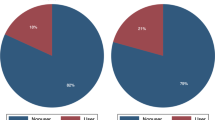Abstract
Objective In the 1970s, OCPs and IUDs were the most popular contraceptive methods in Colombia. According to data from the most recent Demographic and Health Survey (DHS), sterilization has become the most common form of birth control in Colombia. This study aims to examine the characteristics of Colombian women desiring long-acting contraception. Methods This study uses the 2005 and 2010 Colombian DHS dataset. Women who choose long-acting contraception were divided into those using female sterilization and those using long-acting reversible contraception (LARC). A multivariate logistic regression model was used to compare demographic and social determinants of contraceptive choice among reproductive age women seeking long-acting contraception between the years 2005 and 2010. Results Among women using a long-acting contraceptive method in 2010, compared to 2005, women were significantly more likely to be sterilized (1.14 OR, 95% CI 1.09–1.18) and less likely to use LARC (0.88 OR, 95% CI 0.85–0.92). Of women seeking long-acting contraception, those exposed to a family planning provider were less likely to undergo sterilization (0.54 OR, 95% CI 0.51–0.58) and more likely to use LARC (1.84 OR, 95% CI 1.73–1.96). When compared to all contraceptive users, younger women and women with less than two children were more likely to use LARC than sterilization. Conclusion Between 2005 and 2010, an increase in the proportion of contracepting women being sterilized in Colombia occurred. Our findings suggest that exposure to a family planning provider and appropriate contraceptive counseling appears to be key determinants of long-acting contraceptive choice. To improve use of long-acting, effective contraception, efforts should be made to increase access to family planning providers.
Similar content being viewed by others
References
Acosta de Hart, H., Umana, C., & Villarreal, C. (2002). Orientame: Preventing and solving problems related to unwanted pregnancy for 25 years in Colombia. Reproductive Health Matters, 10(19), 138–142.
Ali, M. M., Cleland, J., & Shah, I. H. (2003). Trends in reproductive behavior among young single women in Colombia and Peru: 1985–1999. Demography, 40(4), 659–673.
Bellizzi, S., et al. (2015). Underuse of modern methods of contraception: Underlying causes and consequent undesired pregnancies in 35 low- and middle-income countries. Human Reproduction, 0(0), 1–14.
Bertrand, J.T., Santiso-Gálvez, R. & Ward, V.M. (2015). Family Planning in Colombia: The Achievements of 50 Years. Chapel Hill, NC: MEASURE Evaluation
Blumenthal, P. D., Voedisch A., Gemzell-Danielsson K. (2011). Strategies to prevent unintended pregnancy: Increasing use of long-actibg reversible contraception. Human Reproductive Update, 17(1), 121–137.
Bursac, Z., Gauss, C. H., Williams, D. K., & Hosmer, D. W. (2008). Purposeful selection of variables in logistic regression. Source Code for Biology and Medicine, 3, 17. doi:10.1186/1751-0473-3-17.
Cohen, S. A. (2009). Facts and consequences: Legality, incidence and safety of abortion worldwide. Guttmacher Policy Review, 12(4), 3–6.
DHS (2011). Colombia (2010) results from the demographic and health survey. Studies in Family Planning, 42(4), 299–304.
Grant, M. (2005) Contraception as a Development? New Evidence From Family Planning in Colombia. NBER Working Paper No. 11704. 2005: 1–55.
Guttmacher Institute. Unintended Pregnancy and Induced Abortion In Colombia. Fact Sheet. 2013.
Guzman, J. M., Singh, S., Rodriguez, G., & Pantelides, E. A. (Eds.). (1996). The Fertility Transition in Latin America. New York: Oxford University Press.
Haddad, L. B., & Nour, N. M. (2009). Unsafe abortion: Unnecessary maternal mortality. Reviews in Obstetrics and Gynecology, 2(2), 122–126.
Heaton, T. B., & Forste, R. (1998). Education as policy: The impact of education on marriage, contraception, and fertility in Colombia, Peru, and Bolivia. Social Biology, 45(3–4), 194–2133.
International Planned Parenthood Federation (IPPF). 2013. Retrieved May 26, 2016. http://www.ippf.org/our-work/where-we-work/western-hemisphere/colombia.
Jones, J., Mosher, W.D. & Daniels, K. (2012). Current contraceptive use in the United States, 2006–2010, and changes in patterns of use since 1995, National Health Statistics Reports. Hyattsville, MD: National Center for Health Statistics.
Joshi, R., Khadilkar, S., & Patel, M. (2015). Global trends in use of long-acting reversible and permanent methods of contraception: Seeking a balance. International Journal of Gynecology and Obstetrics, 131, s60–s63.
Kendall, T., & Albert, C. (2015). Experiences of coercion to sterilize and forced sterilization among women living with HIV in Latin America. Journal of the International AIDS Society, 18, 19462.
Lawrence, R. E., Rasinski, K. A., Yoon, J. D., & Curlin, F. A. (2010). Factors influencing physicians’ advice about female sterilization in USA: A national survey. Journal of Human Reproduction, 26(1), 106–111.
Leite, I. C., Gupta, N., & Rodrigues, R. N. (2004). Female sterilization in Latin America: Cross-national perspectives. Journal Biosocial Science, 36(6), 683–698.
Mundigo, A.I. (1992). The role of family planning programmes in the fertility transition of Latin America. Notas de Población, 20(55), 11–40.
Prada, E., Singh, S., Villarreal, C. (2012). Health consequences of unsafe abortion in Colombia, 1989–2008. International Journal Gynaecology Obstetrics, 118(Suppl 2), S92–8.
Reilly, P. (2015). Eugenics and involuntary sterilization: 1907–2015. Annual Review of Genomics and Human Genetics, 16, 351–368.
Rosenberg, J. (2004). Increase in sexual activity among young colombian and peruvian women exceeds rise in contraceptive use. International Family Planning Perspectives, 30(2), 99–100.
Ruibal, A. (2014). Movement and counter-movement: A history of abortion law reform and the backlash in Colombia 2006–2014. Reproductive Health Matters, 22(44), 42–51.
Rutenberg, N, Ayad, M. Ochoa, L. H. & Wilkinsoin, M. (1991). Knowledge and use of contraception. Demographic health surveys comparative studies, Columbia, MD: Macro International.
Winner, B., Peipert, J., Quihong, Z., Buckel, C., Madden, T., Allsworth, J., & Secura, G. (2012). Effectiveness of long-acting reversible contraception. The New England Journal of Medicine, 366, 1998–2007.
Zampas, C., & Lamačková, A. (2011). Forced and coercive sterilization of women in Europe. International Journal of Gynaecology and Obstetrics, 114(2), 163–166.
Author information
Authors and Affiliations
Corresponding author
Rights and permissions
About this article
Cite this article
Folch, B.M., Betstadt, S., Li, D. et al. The Rise of Female Sterilization: A Closer Look at Colombia. Matern Child Health J 21, 1772–1777 (2017). https://doi.org/10.1007/s10995-017-2296-x
Published:
Issue Date:
DOI: https://doi.org/10.1007/s10995-017-2296-x




